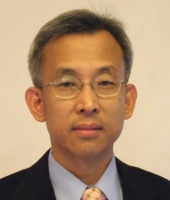Topic: Multiferroics
Speaker: Prof. Sang-Wook Cheong
Rutgers Center for Emergent Materials, Rutgers University, USA
 CV-Prof. Sang-Wook Cheong
CV-Prof. Sang-Wook Cheong
Abstract:
Multiferroics are novel materials where ferroelectricity and magnetism coexist and couple to each other. Until recently, only a small number of single-phase multiferroics were known, and the observed magnetoelectric effects were mostly linear and small. Recent discoveries of novel oxide multiferroics (e.g. Tb(Dy)MnO3 and Tb(Dy)Mn2O5) with highly-non-linear and large magnetoelectric effects have resulted in a spectacular progress in this field [1]. Colossal magnetoelectric effects, such as the flipping of electric polarization, huge change of dielectric constant with applied magnetic fields, or large magnetization change induced by applying electric fields, have been reported. These effects open up entirely new ways of phase control with potential for device applications in many areas, such as transducers, field sensors, data recording, etc. The origin of colossal magnetoelectric effects is associated with the high sensitivity of “collective” magnetoelectric states to external stimuli.
BiFeO3 is a unique multiferroic in the sense that the system is magnetic and ferroelectric at room temperature, and ferroelectric polarization is large in magnitude – as large as that of PbTiO3 that is the ferroelectric oxide with the largest polarization. We will discuss the details of magnetism and ferroelectricity in this intriguing compound [2].
The fascinating concept of topological defects permeates ubiquitously our understanding of the early-stage universe, hurricanes, quantum matters such as superfluid and superconductors, and also technological materials such as liquid crystals and magnets. Topological defects have been recently discovered in multiferroic hexagonal REMnO3 (RE= rare earths) with RE=Ho-Lu, Y, and Sc [3]. These defects accompany non-trivial vorticity in terms of ferroelectricity and magnetism, and occur in pair, so can be called as multiferroic vortices and antivortices. It turns out that the appearance of these vortices and antivortices are closely related with the Kosterlitz-Thouless phase transition. In addition, the pattern of numerous vortices and antivortices appear random, but can be neatly analysed by graph theory [4].
[1] Multiferroics: a magnetic twist for ferroelectricity, Cheong S-W. and Mostovoy M., NATURE MATERIALS 6, 13-20 (2007).
[2] Switchable Ferroelectric Diode and Photovoltaic Effect in BiFeO3, Choi, T., Lee, S., Choi, YJ., Horibe Y, and Cheong S-W., SCIENCE 324, 63-66 (2009).
[3] Insulating Interlocked Ferroelectric and Structural Antiphase Domain Walls in Multiferroic YMnO3, T. Choi, Y. Horibe, H. T. Yi, Y. J. Choi, Weida. Wu, and S-W. Cheong, NATURE MATERIALS 9, 253 (2010).
[4] Self-organization, condensation, and annihilation of topological vortices and antivortices in a multiferroic, S. C. Chae, Y. Horibe, D. Y. Jeong, S. Rodan, N. Lee, and S.-W. Cheong, PNAS 107, 21366 (2010).



